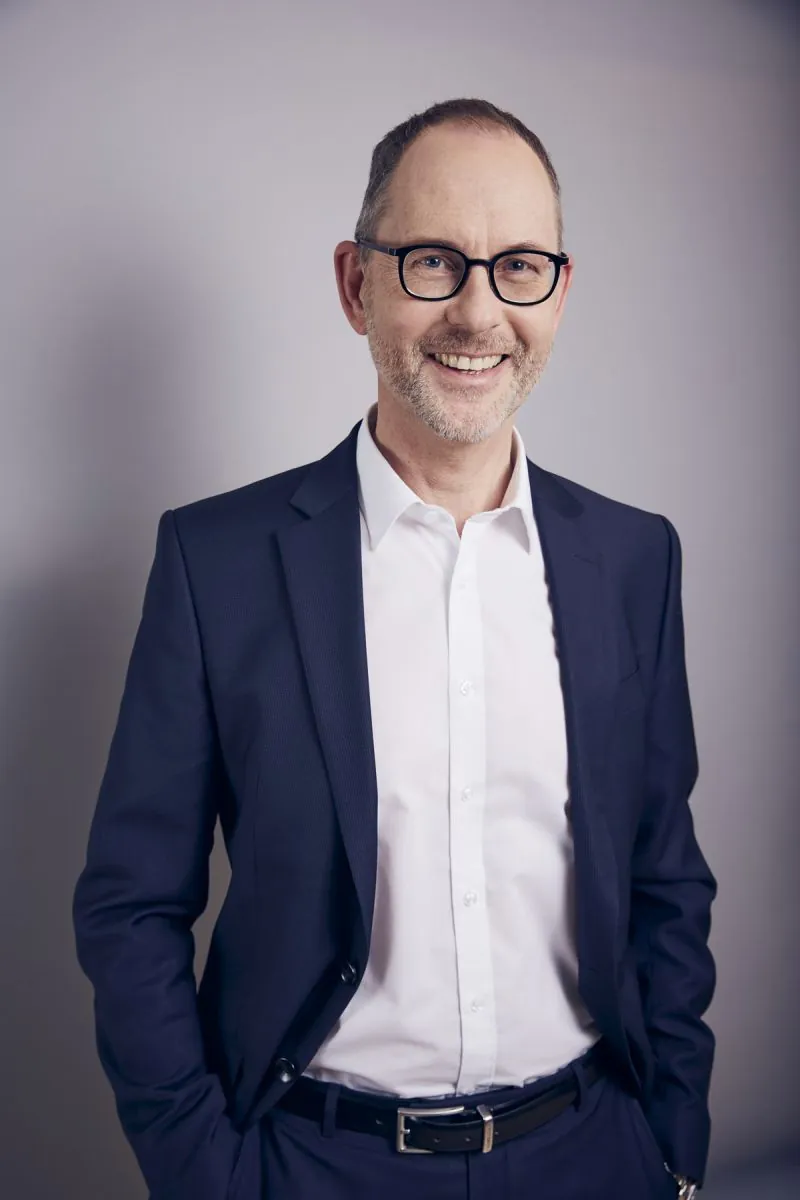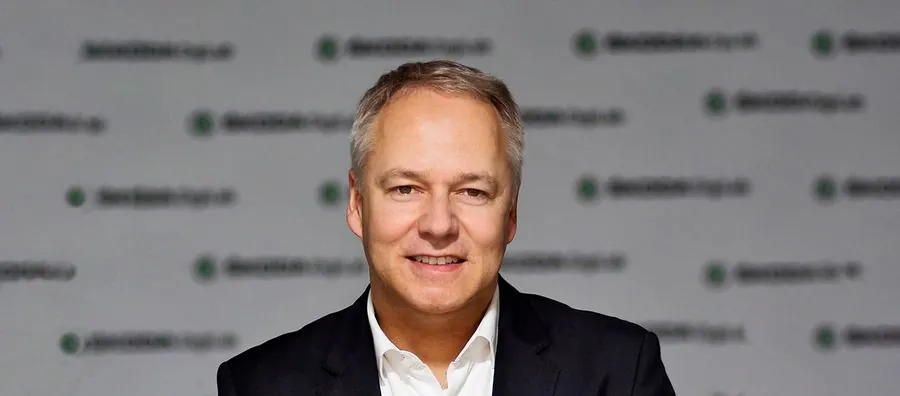
IT Organisation 2025

“Data must be protected, but above all it must be used”
Organizing into product teams for digital services is exhausting, but a sensible investment in the company’s future, explains Dr. Roland Werner, Head of Digital of the global IT division at Eschborn-based energy service provider Techem, in conversation with Thomas Heinevetter, Managing Director of kobaltblau Management Consultants GmbH.
Wie entwickelt sich das Zusammenarbeitsmodell und die Zukunft der IT-Organisation?
Thomas Heinevetter: How will the collaboration model and the future of the IT organization at Techem develop? I will present four possible scenarios: 1. the extreme model, the complete integration or merging of business and IT with end-2-end product teams. 2. a strong fusion – keyword platform IT. IT is divided into two parts. The application-oriented part merges with the business to form end-to-end product teams. The second part of IT remains as a separate organizational form and serves as a platform provider. 3. partial fusion or product IT, with virtual product teams as a layer above the classic organizational forms. 4. weak fusion or hybrid IT; this is similar to today’s organization. Although there are virtual teams, the classic plan-build structure is dominant.
Dr. Roland Werner: Digitization of processes only works with a team. It requires the integration of domain and IT knowledge. The introduction of multidisciplinary product structures is ideal: with technical experts, product managers, process experts and even IT specialists. We are in the decisive areas on the way to scenario two – with tribes and squads.
Heinevetter: Are there departments that are predestined for pilot projects because they already have a high level of IT integration?
Werner: Customer products, which have a high proportion of data-driven content, are our top priority. They are at the heart of the value chain. The pressure to digitize can be mitigated here, particularly in the direction of digital customer interaction. In this area, companies are not only driven by internal motivation for optimization, but also by competition and customer needs.
Heinevetter: What influence do you think the Citizen Developer issue will have on the merger or integration?
Werner: A significant proportion of internal support applications can be supplemented or replaced by low-code approaches in the future. The software developer, in turn, then has the freedom to develop complex, scalable software. However, whether the IT industry will manage to offer corresponding low-code tools for scalable end customer products is another matter. I’m cautious about that at the moment.
Heinevetter: Is there a role for Citizen Developers at Techem?
Werner: In the specialist departments, there are employees who are very self-sufficient and also build suitable tools and apps that go beyond the use of Excel – especially with BI tools. You shouldn’t have to knock on the door of the IT department and make a requirement for the smallest change. The task of IT is to make itself replaceable wherever possible.
Heinevetter: Is shadow IT a challenge or support if specialist departments already have a high affinity for IT tasks?
Werner: Today, our management has a clear and uniform approach to “shadow IT”. In the past, departments have purchased software that then had to be adapted and managed by external parties. This ‘shadow IT’ is currently becoming ‘real IT’ – also driven by increasing IT security requirements. And: both sides gain insights. The specialist departments recognize how complex the topic of IT is, and the IT side realizes that sound domain knowledge is required.
Heinevetter: Which members make up an ideal product team at Techem?
Werner: There are product managers and department employees who think about the external product – about price, competitor offers or customer requirements. It also includes colleagues who understand the service processes and IT specialists who know how and on which platform the processes are optimally supported. The product owner plays an important role in overarching topics, communicating the product goals and features, supporting the team with a strong process and system lead and ensuring transparency and coordination at all times.

Heinevetter: How will demand management continue to develop?
Werner: Demand management is and remains important. You can argue about which tools and techniques to use. I prefer tools in which everyone can document their user stories and in which there is also a joint evaluation. Everyone must be able to contribute stories, IT and business.
Heinevetter: You use terms from the Spotify world, such as squads or tribes. This change in product orientation often also means that the basic set-up between People and Product Lead is changed. How is Techem positioned today?
Werner: Today, we only have a small cross-sectional area that takes care of core services such as IT infrastructure and the data center. The majority of employees, on the other hand, are organized into four so-called tribes – organized according to domains. One tribe is responsible for online services, i.e. portals and apps, and another tribe is responsible for supporting technicians in the field and IoT data transport to the cloud. A third tribe is responsible for and optimizes our core systems for meter reading, billing and customer management. Finally, there is an ERP tribe – for SAP topics and also for internal support processes.
Heinevetter: Is the topic of architecture part of each of the tribes?
Werner: Architecture is a broad term. I differentiate between enterprise architecture as a component of the governance area and solution or software architecture, which belongs to the tribes because it is specific in parts. Skills are kept together in a rather overarching chapter structure – a kind of community in our case. This means that we are organized end-to-end – including the interfaces between systems.
Heinevetter: People and Product Lead are then usually bundled in one person?
Werner: That was also a wish of the employees: certain breaks within IT should be avoided and a certain consistency maintained. We try to clearly assign every system, every product and every project and anchor them together with the specialist departments. My expectation of the Tribe is that it defines its products with its counterpart in the business, demands service and maintains contact with the managers of the squads.
Heinevetter: Then you don’t need resource management?
Werner: A small staff function maintains an overview and manages capacities in the overall team and ensures compliance with governance rules. Because IT needs guard rails.
Heinevetter: Does it make sense to also set up a separate data organization within the company that takes care of all data lifecycle processes centrally, or are these rather aspects that need to be considered decentrally in all teams?
Werner: In principle, all departments and employees should be aware of the importance of data lifecycle topics. A small support team can’t hurt – but it doesn’t have to be based in IT. As part of the business projects, we are now gradually building a modern data platform layer in which all data – including data from legacy systems – is brought together: the “single point of truth” that can serve internal, strategic and tactical processes as well as external customer products.
Heinevetter: Will a Chief Data Officer be necessary tomorrow?
Werner: Dispositive analytics and operational data processing will no longer exist in this form in the future; they will merge. In future, we will make tactical and strategic decisions on the basis of a platform and also serve customers in the portals. Provided that the right software architecture is chosen. Only the cloud comes into question for this with courage and the corresponding skills. Life in a big data world will shape all IT work. And for me, big data means that the analytics must come to the data and not the data to the analytics. Operational data processing, artificial intelligence and machine learning – it all has to take place on this platform.
Heinevetter: Those are very different skills, aren’t they?
Werner: They cross-fertilize each other. Example: Employees need stored data from sensors to be analyzed. However, not everyone is a data scientist. Data scientists must work together with data management specialists in joint architecture rounds or squads in order to obtain meaningful results. The problem is that the understanding of roles often gets in the way – according to the motto: We have to protect the data, it must not be lost and it must not go into the cloud under any circumstances. However, data must not only be protected, but also used at the same time. That is a balancing act. This can be achieved if the CIO also thinks like a CTO. They also need to be familiar with data protection laws and the latest cyber defense techniques and act in the interests of customers and the company.
Heinevetter: What do data scientists do at Techem?
Werner: You generate benefits. We don’t have a data science department that is responsible for basic research. Rather, it has a clear search mandate that is intended to improve products in concrete terms. For example, measurement data is initially analyzed in order to determine requirements for optimizing the data routes. Only then does the data scientist, together with data management, start looking for ways to optimize the product.
Heinevetter: Do you have a core team that takes care of all data-related processes?
Werner: On the IT side, there is an initiative that deals with projects and data analysis in the cloud. An accompanying team focuses on IoT device technology and cloud communication. We also have a team of data stewards who work with the specialist departments to ensure data quality and data protection. The departments and specialized teams work well together across the board. This successful combination works best with people who have a soft spot for technology and also understand the opportunities that lie in the data. Any CIO, CTO or Head of Digital who has not penetrated the possibilities of big data, artificial intelligence and the automation that builds on them will not be able to shape an IT strategy for the next five years.
Heinevetter: What were the success factors in the transformation? Were there any pilot projects?
Werner: The transformation to the cloud started as a ‘big bang’ with decisions in a top-down approach with strategic selection and training as well as “lighthouse projects” – for 160 employees. We are still in the ‘storming and forming’ phase in the development of our tribes and chapters and are also looking for new employees. It was and remains exhausting, but a really sensible investment in the future of the company.
Heinevetter: What are your top 3 areas for action?
Werner:
- We want to enter the performing phase of our organizational structure by the end of the year.
- The powerful teams require appropriate personnel and contracting structures. We are also looking for additional employees.
- The core business must be continuously digitized, while at the same time new digital businesses must be realized.

Dr. Roland Werner
Since April 2020, Dr. Roland Werner as Head of Digital for the global IT division at Eschborn-based energy service provider Techem. Werner is responsible for aligning the Techem Group’s products and services to the respective needs of customers and employees in a targeted and future-proof manner using the latest digital technology. He manages software development and operations on the cloud and in the data center and, together with the Techem departments, software specialists and device development, sets the course for new digital products and value chains. “Digitalization is the most important basis for our products in the areas of energy efficiency and healthy living, for more efficient processes on all sides and for the overall customer experience. My goal is to rethink the topic of innovation and significantly accelerate the digitalization journey at Techem,” says Werner. In his position, he reports directly to Matthias Hartmann, CEO at Techem. The computer scientist with a doctorate comes from IBM. Previously, he held national and international IT positions at the market research company GfK and PwC management consultancy.




